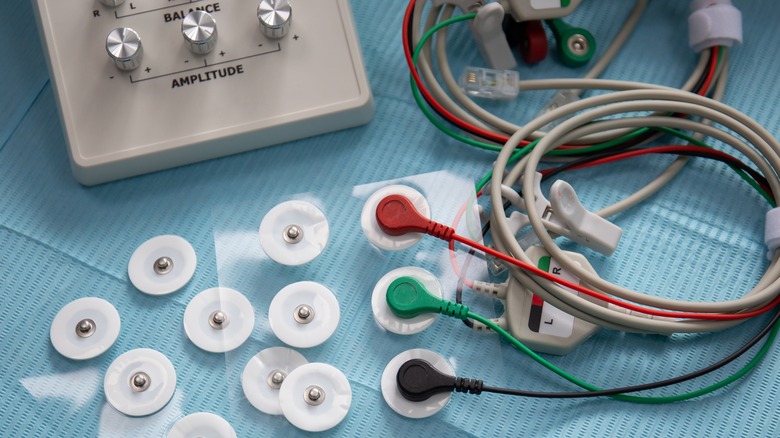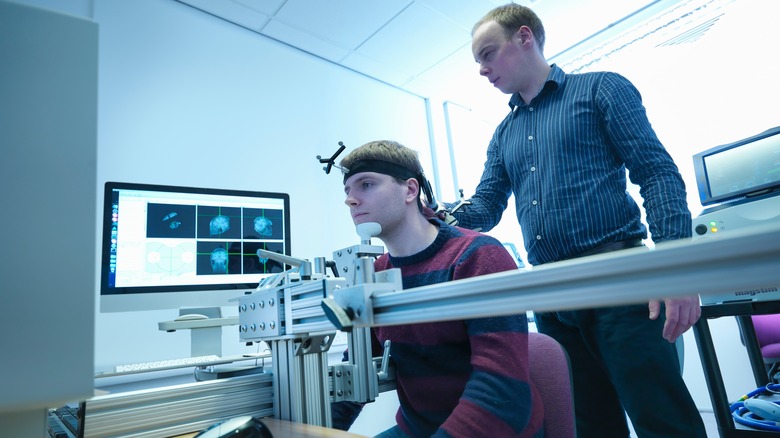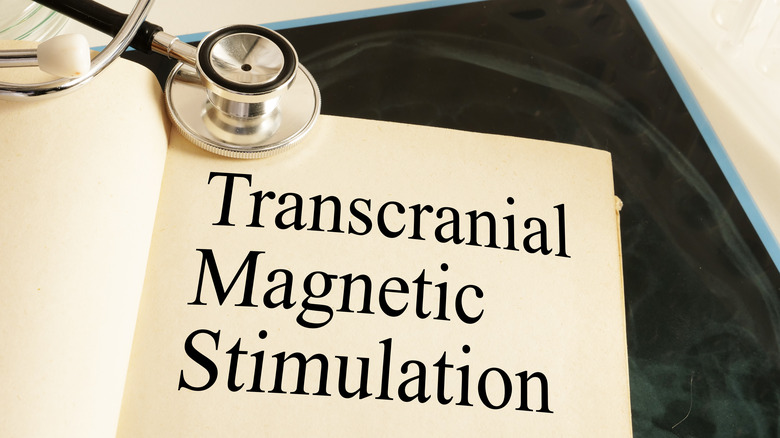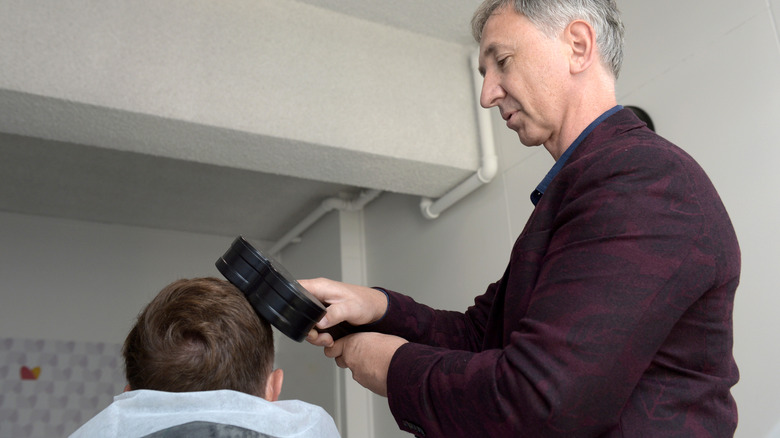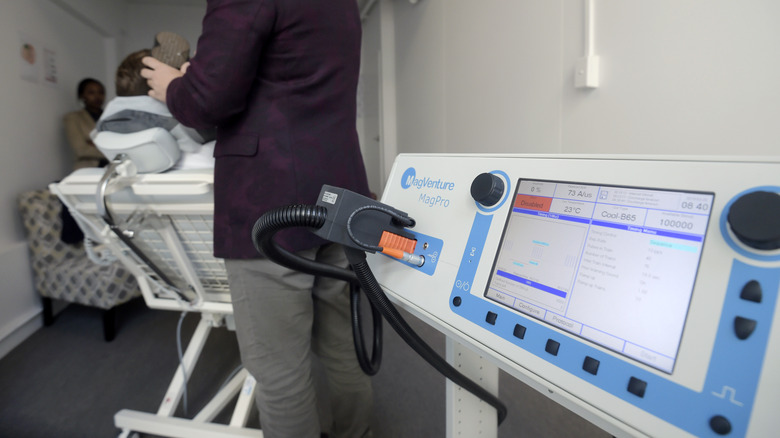What Is Transcranial Magnetic Stimulation & Can It Help With Depression? Here's What We Know
Major depression is a mental health disorder that affects adults, young adults, and even children and teenagers. According to KFF, at least one-third of the adult population in the United States may live with some form of depression and/or anxiety, with those falling between the ages of 18-24 affected at a rate of about 50%. The American Psychiatric Association lists some of the symptoms of depression as feeling down, experiencing decreased interest in things you previously took pleasure in, thinking the world would be a better place without you, excessive worrying, and even feeling more tired than usual. Andrew Leuchter, MD, explained via UCLA Health that "We've come to understand that depression is a disease state of the brain network – wrong connections being formed in the brain."
Standard treatments for depression include medications, talk therapy, and possible hospitalization, but for those whose condition doesn't respond well to these approaches, alternative modalities may be worth exploring. Doctors and scientists have been looking for new ways to help such treatment-resistant patients. From acupuncture to exercise and yoga, all sorts of other options exist (via Cleveland Clinic), and one of the newest varieties being talked about right now is transcranial magnetic stimulation (TMS). However, it's important to fully understand TMS before making a decision about whether it's the solution you've been looking for.
The origin of TMS
Although TMS may be unfamiliar to many, it has actually been around since 1985, as noted by the Iranian Journal of Child Neurology. It wasn't until the early 2000s that the FDA approved TMS as a treatment, making it more widely available to patients. According to Harvard Health Publishing, TMS originated as an alternative to electroconvulsive therapy (ECT), commonly known as shock therapy, which is still used to treat depression and other mental health issues, sometimes to great effect. However, ECT has side effects such as memory loss, confusion, and nausea (per American Psychiatric Association). As detailed by Scientific America, ECT also has a controversial history, largely stemming from fear related to how it was utilized in mental hospitals during the 1950s. TMS was developed as a less invasive alternative to ECT.
Dr. Leuchter told UCLA Health, "We discovered many years ago that ECT was an effective treatment for depression -– you put electricity in the head, which causes a seizure and resets brain frequency. Then we thought, what if we use magnetic waves to accomplish the same thing but without a seizure – resetting brain networks without the ECT side effects." More than half of the people Dr. Leuchter has worked with have found at least some relief with this approach. However, the benefits don't always last, and more research is needed to determine the long-term effects of TMS. Despite this, TMS is still a promising alternative to ECT and other invasive treatments for depression.
How TMS works
Transcranial magnetic stimulation, as the name suggests, "uses magnetic fields to stimulate nerve cells in the brain" (via Mayo Clinic). An electromagnetic coil is placed on the patient's head to energize parts of the brain that aren't as active as they should be. This stimulation is often compared to the sensation of someone tapping on your head. TMS has been used not only to treat depression but also to help people living with obsessive-compulsive disorder (OCD) and smoking addiction.
Psychiatrist Dr. Daniel Uderitz observed that TMS has been effective for patients who have experienced depression for 20 to 30 years despite trying a range of treatments. "They come and do TMS and say, 'Oh my gosh, it's the first time in 20 years I haven't felt depressed,'" he told The Post and Courier. While TMS may not work for everyone, Dr. Mark George added that "The good news is that if it works once, it's likely to work again." Follow-up sessions are often required to sustain the positive effects, but the number can vary. Doctors keep track of where the stimulation is applied so it can be repeated consistently across visits.
The benefits of TMS Therapy
The benefits of TMS therapy for treating symptoms of depression look promising. According to Healthline, TMS can stimulate nerve cells that have reduced activity. All of the benefits of TMS, no matter whether being used to treat addiction, OCD, or depression, stem from its ability to boost these nerve cells into action. Based on existing data, the number of major depression patients who have experienced positive effects following TMS sessions ranges from 30 to 64 percent. Its usefulness for other conditions requires further exploration.
For OCD, TMS can reduce symptoms. For those with PTSD and anxiety, TMS appears to help control normally uncontrollable fears. TMS not only helps relieve depression, but it may also help with motor cortex stimulation, reducing feelings of chronic pain. TMS therapy is being used to treat additional illnesses, including Parkinson's disease, schizophrenia, multiple sclerosis (MS), Alzheimer's disease, and even stroke recovery. Studies suggest that any illness that affects the brain has the potential to find relief with TMS therapy, though again this merits additional research. While TMS may not reverse diseases like Parkinson's and Alzheimer's, it has been shown to alleviate some of the symptoms.
Best candidates for TMS therapy
TMS is not only used to treat depression, OCD, and nicotine addiction. According to Advanced Psychiatry Associates, if you've unsuccessfully tried medications and other treatments for bipolar disorder, post-traumatic stress disorder (PTSD), anxiety, or even chronic pain, you may be a good candidate for TMS. It also may help with more addictions than just smoking. For each of these illnesses, TMS has supplied benefits, from alleviating some of the depression that comes with bipolar disorder to much of the anxiety that is part of dealing with PTSD. Even the treatment of chronic pain using TMS leans into the fact that this therapy helps with depression, which is something common in those living with chronic health issues of any kind.
To determine if someone is a good candidate for TMS therapy, Rogers Behavioral Health stated that doctors will typically look for a major depression diagnosis, as well as documentation establishing that antidepressants have failed to help the patient with their symptoms. If you feel like you've tried everything and you're still experiencing issues with your mental health, talk to your doctor about TMS and whether it may be able to help you.
How to determine if TMS is for you
Given its potential benefits, you may be wondering if TMS therapy is worth looking into. However, you should only consider this treatment if you've exhausted other options and they've proven ineffective. It also may be a solution for individuals who have experienced unbearable side effects from taking medication. TMS is non-invasive and generally painless, but some individuals have experienced discomfort during the procedure, as reported by The Post and Courier. Consulting with your doctor is the best way to determine if TMS is a viable treatment option for you, as they have access to your medical history and know what has already been tried (and failed) in treating your mental health concerns.
During your consultation, the doctor will look at certain factors such as your medication regimen and history of seizures, according to Advanced Psychiatry Associates. TMS can raise the risk of seizures in people who have a history of them or epilepsy. In rare cases, it also may not interact well with bipolar disorder. Additionally, any metal you may have in your head from previous surgeries or other scenarios can also pose a problem and will need to be taken into consideration when determining whether you're a good candidate for TMS therapy.
Different ways to perform TMS
There are different ways your doctor may administer TMS therapy to you, as documented by Cleveland Clinic. The strength of the magnet can be adjusted, typically between 1.5T to 2T (tesla), much like an MR scanner. However, unlike an MRI, TMS covers a smaller surface area. Adjusting the tesla output between these two points can affect the treatment. Different types of coils can be used to target different parts of the brain. For a deeper reach, a coil shaped like an "H" may be used.
The TMS unit puts out pulses, which is what some folks find uncomfortable. The frequency and patterns of these pulses can be altered. Different frequencies, such as repetitive, slow-, or high-frequency pulses, can have a more powerful effect and your doctor may switch between them when one type isn't working. The lowest frequency used is 1 Hz, while the higher frequencies can range from 5 Hz to 10 Hz. Your doctor will determine which of these treatments is best for your specific condition. Since the treatment will typically be administered to the same parts of your brain each time, your doctor may change pulse rates and other aspects of treatment if no change is noticed after a certain number of visits.
What to know before treatment
If your doctor has agreed that TMS is right for you, it's time to prepare for the actual treatment. Much like a therapy session, your doctor will ask you some questions prior to treatment. The questions will revolve around your mood, what you've been eating, medications, your sleep schedule, and any changes you may have made to your routine. Consistency is key for the treatments to have their best effect on your brain, according to Mindpath Health. If you've made changes, you may need to reschedule your appointment. You may be asked more questions at consecutive appointments that will help the doctor see how the treatments are working for you.
Your initial appointment will be a lengthier one, as the doctor needs to map your brain to ensure the consistency of treatments. This will also help them determine when changes need to be made or if TMS can stop. You'll be seated comfortably for the treatment and a normal session will usually last less than half an hour. Feel free to bring reading materials with you to help pass the time.
What after treatment looks like
As an outpatient service, there's no stayover in the hospital after your TMS treatment since it's non-evasive. You can go back about your daily business once you're done. However, according to Mindpath Health, some people may experience small headaches after a session, so you might need to take a short break before returning to work. You may also feel a little sleepy once the treatment is done, but your doctor will likely advise you to skip taking a nap for an hour or so after your treatment to ensure better results. The Mayo Clinic noted that there's also a chance of scalp sensitivity and lightheadedness. Some people have even reported minor muscle spasms, however, all of these side effects should fade within an hour or so.
If you experience side effects that persist, reach out to your doctor. If you regularly get headaches that won't dissipate, your doctor may need to discontinue your treatments. You should also let your doctor know when you begin to notice a difference in your depression and anxiety symptoms.
The cost of TMS
There are multiple aspects to look at when it comes to TMS treatments, beginning with finding out whether or not your insurance might cover all or part of the cost. Since TMS is an FDA-approved therapy for major depressive disorder and OCD, there is a better chance of getting it covered. However, according to Healthline, all insurance companies have different stipulations, so your coverage may depend on how many other types of treatments you've had, and it could also take a while for your insurance company to okay treatment. If TMS seems right for you, but your insurance doesn't cover it and you don't think you can afford to pay out-of-pocket, consider researching insurance companies that have covered this type of treatment before. If you have a health savings account, you could also put that toward your treatments.
Without coverage, the cost of TMS varies because of the different types of treatment and because patients have their own needs based on their disorders. Someone who only requires one treatment will pay much less than someone who has to go in for weekly treatments several months in a row. The cost could be as low as $2,000 (via BetterHelp) and as high as $12,000 to complete a full course of treatment, according to GIA Miami, with the average cost of individual sessions coming in at around $300. Like all medical expenses, prices can vary between doctors and locations.
Does it work?
As is often the case with medical treatments, TMS seems to work for many, but there's no guarantee that it will work for everyone. Dr. Leuchter told UCLA Health, "We're still trying to understand how some patients do two treatments and they're well and for others, it takes 20 treatments before they start to feel better." Treatment can vary wildly depending on the patient, similar to how some patients require a higher dosage of medications than others.
Leuchter also pointed out that many of his patients' symptoms have improved significantly with treatments. In fact, he claimed that nearly three-quarters of them have enjoyed benefits for an entire year. However, as noted in Psychiatry (Edgmont), most of the studies done so far on using TMS to treat depression have only dealt with small sample sizes, so it's difficult to definitively determine its actual effectiveness.
Varun Sharma, MBBS, a psychiatrist at Nebraska Medicine, explained that "Depression is a chronic condition with waves of remission and relapse," and added that "It's not like a broken bone that is fixed or cured, but rather a chronic illness. The goal is remission to reduce symptoms and improve quality of life using the treatment with the least side effects. We want to lengthen the time we keep depression symptoms at bay.".
Downsides of TMS therapy
While we already covered some of the drawbacks of this type of therapy – such as the cost and other medical considerations that may impede your treatment – another factor that may give you pause is the level of commitment required. You may need daily or weekly treatments, which can add up to a lot of money and a lot of time away from the other areas of your life. However, if it treats an illness that keeps you from enjoying that life, it may be worth the investment.
Some people don't like the temporary headaches, possible scalp pain, and short-lived facial twitches that this treatment can cause, but these tend to wear off quickly. Similar to the dangers of antidepressant use, TMS can cause people living with bipolar disorder to experience hypomania and manic episodes (via the Journal of Neuropsychiatry and Clinical Neurosciences), which can be incredibly hazardous to their well-being and lead to hospitalization. Brain Stimulation also noted that the sound of the pulses can lead to loss of hearing (both temporary and permanent), so it's essential to wear hearing protection.
It's also important to remember that some forms of depression are chronic, and even when you feel as though you're on cloud nine, those feelings may come back. Moreover, there is a chance that TMS treatment won't work for you at all.

